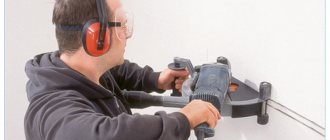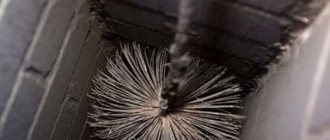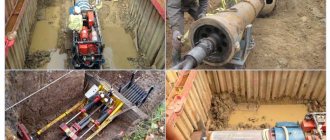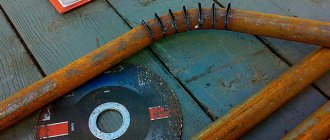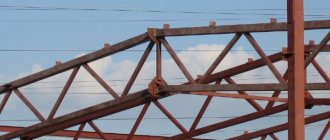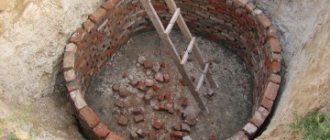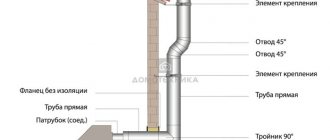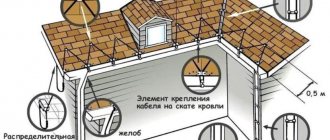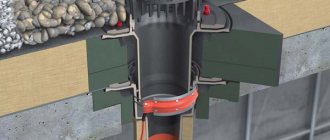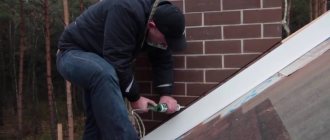Installation of a drainage system is an important stage in the construction of any home. Therefore, before purchasing it, it is important to calculate everything correctly.
How to calculate the drain yourself and buy the required number of elements? This is not very difficult, and in our article we will calculate the external drainage for a pitched roof.
As an example, consider the option of a pitched roof. In the future, based on this calculation, you can simply multiply the amount of materials by the number of slopes.
Gutter section
The shape of drainage systems can be round or rectangular. By and large, this does not affect anything except aesthetics.
The size of the drainage system is much more important. As a rule, for a private house the volume of standard structures is always sufficient, so you don’t have to bother with calculating the diameter of the drain.
A simple example: the minimum diameter of gutters from Metal Profile is 120 mm - designed for slopes with an area of up to 80 m2. For a private home this is a lot. Enlarged gutter 150 mm – up to 110 m2. For large objects, the industrial series “Project” is produced with 185 mm gutters, which can serve slopes up to 180 m2.
Dimensions and geometry of plastic gutters
There are no generally accepted standard sizes of plastic gutters; each manufacturer produces products according to personally developed specifications.
Plastic gutter size (manufacturer: TechnoNIKOL company)
Dimensions of elements of the Döcke PREMIUM drainage system
Dimensions of the Döcke LUX drainage system elements
When calculating the linear parameters of gutters and their profile, designers must take into account the characteristics of roofs. Roofs have a clearer classification; this determines the gutter sizes of all manufacturers are more or less the same; deviations of a few centimeters do not have any effect on performance indicators.
Depending on the type of gutter profile, there are:
- semicircular. Their profile is part of a circle limited by diameter. This form of gutters is considered universal and is most often used. The geometry of the element makes it possible to achieve maximum diameter with minimal losses of materials, and this has a positive impact on the formation of low prices. The diameter of semicircular gutters is 70–170 mm, cross-sectional area is 24.8–143 cm2. Most often, the joints are sealed with rubber gaskets, and the connection is locking. This is explained by the fact that rubber sealing works well on surfaces of regular geometric shape without sharp corners;
Semicircular gutter
- complex. They may have the appearance of a truncated trapezoid; the side can be flat or convex. Elements that are more complex from a technological point of view are more expensive than semicircular ones. Advantage - they can pass an increased volume of water with the same width. Disadvantages - the connection of gutters must be done using glue; only in this way can the sharp corners of the elements be reliably sealed.
Rectangular gutter
Gutter length
Gutter – ensures the evacuation of melt and rain water from the roof of the building.
When calculating the number of gutters for drainage, you should proceed from the length of one product and the length of the cornice, plus the overlap for installation. For example, the standard length of gutters from Metal Profile is 3000 mm. The overlap usually takes 3-4 cm. Thus, if we have a 10-meter cornice, we will need:
- 4 gutters 3 meters each. Their total length will be 12 m, so you just have to cut off the excess;
- 3 gutter connectors, they provide airtight fastening of the gutters to each other or to the corners of the gutter;
- 2 plugs (left and right), since the roof is pitched, the gutter does not go around the entire perimeter of the roof. Place plugs at the ends; they add rigidity to the structure and serve as a stopper for water.
Advantages of using plastic drains
Plastic gutters have many positive parameters, due to which they are very popular. Some owners of residential buildings, even if they have the financial ability to purchase metal parts, still choose plastic elements, but they choose types made from really high-quality polymer.
The main positive operational parameters of plastic drainage include:
- resistance to the corrosion process, so constant exposure to water will not cause destruction of the main parts of the structure;
- low weight, which is considered one of the most important advantages of these elements, since plastic parts are much lighter than metal ones, so transportation and installation are considered simpler and faster processes;
- during rain, there is no strong and unpleasant sound when water is removed from the roof, but metal parts have a high resonating ability, so if they are present, a strong noise of falling water appears;
- ease of installation allows each home owner to carry out the installation independently, since all elements are easily joined to each other, and for this there is no need to use any specific tools or welding, and even such fastening is reliable and durable;
- low cost of various elements, and even fasteners are considered more affordable compared to the use of metal gutters;
- long service life, which can even reach 60 years, during which there is no need to carry out any complex repair work at all;
- the ability to choose elements with different colors, so a system is selected that is perfectly suited to the appearance and shade of the walls of the building or the roofing material chosen on the roof.
Important! Every owner of a private house should know that PVC gutters change their volume when the temperature changes, so often the elements are completely deformed or destroyed during sudden freezing and defrosting, so installation must be done using compensation elements.
Brackets
The gutter holder and the cornice gutter holder differ from each other in length. They both fix the gutter on the roof, but the regular holder (longer) must be installed BEFORE installing the roofing, and the cornice holder can be attached after the roof is finished.
Conventional chute holders are usually spaced 60 cm apart, sloping towards the outlet funnel. When calculating the slope of the drain, keep in mind that it can range from 3 to 5 mm for each meter of length. For a 10-meter cornice we need 17 gutter holders.
Let's calculate the drain using the example of a gable roof!
To calculate the drainage, you need to know two main dimensions, all the lengths of the cornice and the height of the walls. We will calculate the drainage system for a gable roof, the length of the eaves is 9 meters, and the slope is 5 meters, the slope area is 45 m2, the roof area is 90 m2. The height from the ground to the edge of the cornice is 2.8 meters. If you have any questions or difficulties in the calculation, be sure to call our managers, they will be happy to advise you and calculate the drainage. You can also watch video instructions in the installation of a drainage system section.
Drainpipes
Drainpipe – provides vertical water flow, can be 2 or 3 meters long, crimped on one side.
The number of vertical pipes and drain funnels is calculated according to the general rule: for every 10-12 m of gutter there is one drain riser. And therefore one outlet funnel.
Where to install it depends on your preferences. For a pitched roof 10 m wide, one riser will be sufficient. In this case, when calculating the elements, you need to take into account the height of the building and the length of the eaves overhang. Let's assume that the height of our house is 4 meters, and the eaves overhang is 50 cm. Thus, we will need:
- 1 outlet funnel;
- 2 elbows - they change the flow of water depending on the architecture of the building;
- 1 connecting pipe – installed between the elbows, its length is 1 meter, crimped on both sides;
- 2 drainpipes 2 meters each;
- 7 pipe holders for wood or brick - they are necessary for fixing the pipe to the facade, installed every 50 cm;
- 1 drain elbow - it must be installed at the bottom of the riser. This is not only a decorative element - it also diverts water from the facade beyond the blind area so that the foundation is not washed away.
Rules and procedure for installing drainage systems
When installing brackets for installing the system, you must maintain the required slope towards the funnel - it should be 4 mm per 1 meter of the width of the roof slope. This is necessary so that water naturally flows from the gutter into the funnel and is directed away from the object. The outermost mounting brackets of the drainage system must be mounted with a distance of at least 15 cm from the corner.
After installing the brackets, water inlet funnels are attached to them. The polymer gutters are then cut to the required size. Any burrs that appear on the edges are removed using sandpaper. After this, the gutters are installed on brackets, connecting the edges of the elements with mechanical locks provided by the design by snapping them with special clamps.
Central gutter funnel PVC Murol 80/100mm brown
Then the corner elements of the system are installed where the gutters change direction, the free edges are covered with plugs. Nets are installed to protect gutters from debris and leaves. Markings are made on the walls at the points where the clamps holding the drainpipes will be installed. The step between the clamps should be no more than two meters.
After installing the clamps, attach an elbow, a section of pipe, and another elbow to the funnel. Next, the main drain pipe is connected. The connections are snapped into place with clamps, secured using special locks. Murol drainage is discharged, like any other system, into a storm sewer or drainage sewer system.
Additional items
If the roof has a complex shape, then it is better to place risers at all corners, especially under valleys, where the flow of water from two slopes simultaneously is quite intense. If the roof has a large slope in such a place, it is better to install a drainage funnel instead of a standard outlet - it has a larger diameter. Overflow limiters will also come in handy.
For a hip or other roof, where the gutters are closed into a single perimeter, we will also need the following elements:
- gutter angle – connects the gutters at the external and internal corners of the eaves, their number depends on the geometry of the building;
- tee (optional) – necessary to connect two drainage pipes into one drain.
Don’t forget to prepare sealant for installation to coat the joints and repair enamel in case of minor scratches.
Construction device
Plastic drainage systems are considered a good choice if you choose all the elements wisely. Modern manufacturers offer structures made from polyvinyl chloride, a thermoplastic polymer. It occurs during oil refining, but is safe, so it can be used for residential buildings.
Important! The best manufacturers actually offer a variety of different elements that act as components of a full-fledged drainage system, therefore, with their proper selection and connection, the required configuration is ensured.
Plastic gutters consist of the following elements:
- Gutters. Their main purpose is to receive water that flows from the roof slope, after which it is directed to the water intake funnel. Due to the fact that plastic is used to produce the gutter, it is possible to choose the design of the optimal cross-section and size, since metal products are usually presented in standard dimensions,
Bottom line
As you can see, calculating a drainage system for a private house is not so complicated.
The main thing is to find out in advance all the parameters of your building: the height of the walls, the length of the eaves overhang, the length and width of the slopes.
However, if you are not sure of your calculations or are afraid of forgetting something, you can always test yourself using online calculators on the manufacturers’ websites.
They are good because the system will offer you all the required elements of a drain. When doing manual calculations, it’s easy to forget about some connectors and holders. Here it will be clearly shown: what is installed where and what it is used for.
The system will also calculate the approximate cost of the structure. The only disadvantage of such calculators is that they, as a rule, offer the amount of materials with a reserve. However, this can easily be adjusted to suit your personal requirements.
Disadvantages of using plastic drains
The use of such parts not only has advantages, since such a system has some significant weaknesses. They must be taken into account when choosing and installing, and these include:
- Low resistance to various mechanical shocks and other types of influences. It is poor strength that is considered the most important design flaw, so if snow avalanches from the roof, this can cause a significant violation of the integrity of the PVC system. Therefore, such products are rarely used on large houses or high-rise buildings.
- Specific calculations are required to determine what the optimal gutter cross-section is. How effective the removal of water from the roof will be depends on the optimal cross-section of this element, so complex calculations have to be made, which takes into account the area of the slope, the average amount of precipitation per year, as well as the climate conditions where the specific structure is located. To calculate, you can use modern unique online calculators, which are freely available on the Internet. If you choose the wrong gutter section, this can lead to rapid deformation of the structure, so you will have to redo it again.
- Lack of stable sizes. Plastic drainage changes volume at different temperatures, so it expands at high temperatures and contracts at low temperatures. This leads to the fact that it is not allowed to rigidly fasten the elements, otherwise there is a high probability of ruptures. Also, to reduce the effect of temperature on plastic, special compensation elements made of rubber are used. They allow the elements to move a little without compromising their integrity.
Important! To create a system, it is advisable to use parts produced by the same manufacturer, since otherwise there is a high probability that they will not fit together due to a slight difference in size,
How to organize heating of gutters and drains and why it is needed
The best protection for the drainage system from freezing in winter is artificial heating. The icing system allows you to heat the drain and prevent the water from freezing. Structurally, the system includes heating cables, temperature and humidity sensors, fasteners, and a control panel. Cables can be used either simple resistive (heating) or more complex and expensive self-regulating ones, in which individual sections of the cable are switched on when cooled below a given temperature.
The number and power of cables are influenced by many factors - pipe diameters, the difference between day and night temperatures in your area, the length of the drainage system, the material of gutters and pipes. Therefore, to design a heating system, you need to contact a specialist.
Which gutter is better: plastic or metal?
Every developer has a question about what material to choose a drainage system from and how to install it. During operation, plastic gutters and pipes are constantly exposed to external factors: in addition to rain and solar radiation, they experience temperature changes, strong winds, and snow loads (when layers of snow slide off the roof). The surface of the drain can be scratched by ice, branches, and tree leaves; Icicles may freeze on the elements. The material of the structures must be smooth and not rust. The entire drainage system must maintain aesthetics throughout its entire service life, not fade or become covered with rust stains, mold and moss.
A plastic drainage system combines many of the qualities required for an ideal drainage system. Therefore, most often they choose plastic structures that have an optimal price-quality ratio. Copper, stainless steel, aluminum, titanium-zinc are expensive or very expensive; galvanizing is not very aesthetically pleasing, is short-lived, and rusts very unsightly. Galvanization with a plastic coating is good, but when cutting elements it also begins to rust from the cut point.
Where can I buy
You can buy plastic drainage elements anywhere. High-quality products - only in construction hypermarkets or large construction stores, with a certificate, receipt and guarantee. You should not take the cheapest drainage system, but chasing the price is also not an option. Better than a proven average. Inspection of purchased materials is still required - there should be no chips, cracks, burrs, uneven coloring, and when purchasing in hot weather, the material should not be too soft. It will not be possible to check plastic products for fragility - no one will allow you to break the products. The surface should be very smooth.
approximate price
The approximate cost of a white plastic gutter with a running diameter of 125 mm and a length of 3 m is from 406 rubles, a pipe with a diameter of 125 mm and a length of 3 m is from 470 rubles, and a corresponding funnel is from 222 rubles. Colored products are 10–15% more expensive.
